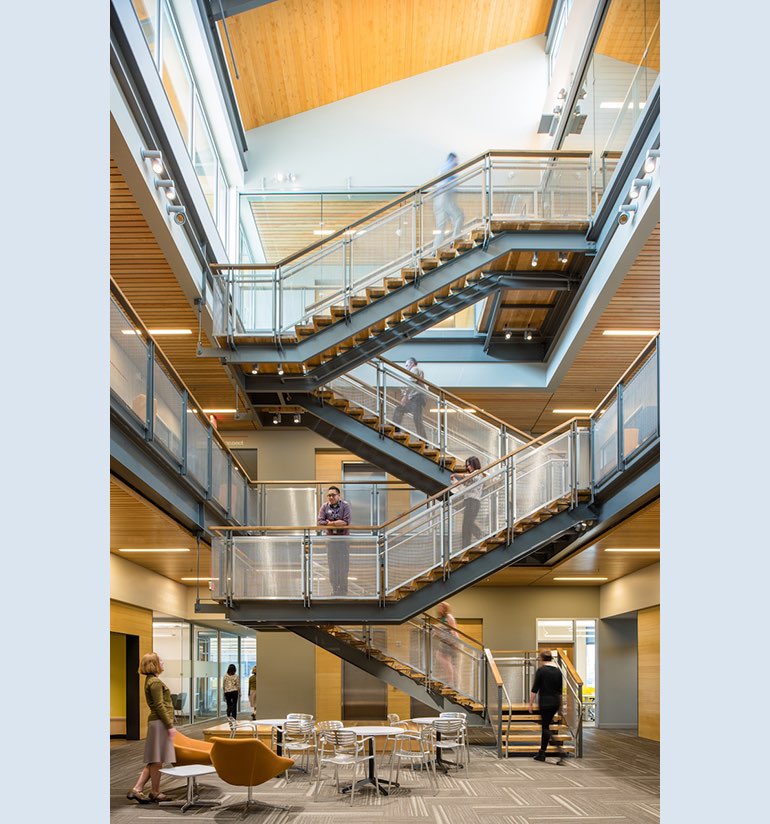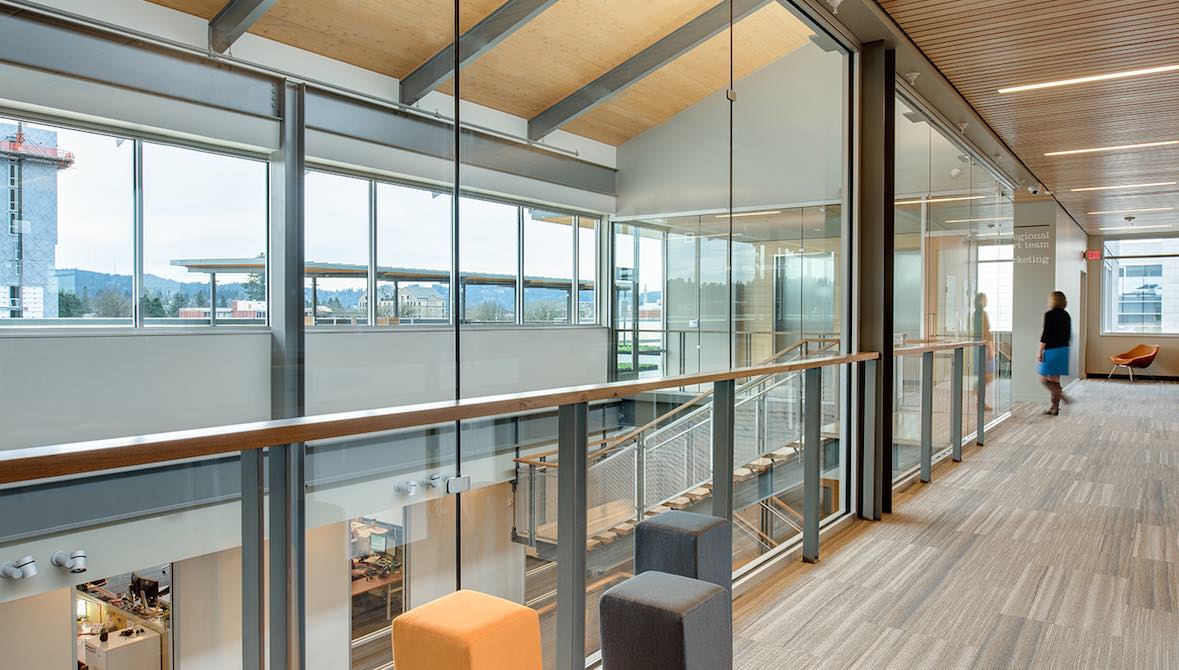5 minutes
Employers can help stave off seasonal and workplace depression by providing mental health resources and implementing these office design tips.
(Pictured above: Northwest Community Credit Union’s headquarters in Eugene, Oregon.)
Countless studies have proven the correlation between light, well-being and performance. The coming of winter reminds us about the importance of light in the workplace. While winter might mean we don’t have to mow the lawn, it also means we have less time for outdoor activities and a decline in the available sunlight that is essential to our physical and mental well-being—and our performance at work.
Unfortunately, these darker days impact us in darker ways. While many people look forward to winter with the promise of skiing and other cold-weather activities, it is estimated that 5% of the U.S. population experiences despair and hopelessness during this season. This number ranges from 0 to 10% depending on how far someone lives from the equator. Others on this continuum may feel moody, lethargic or irritable and experience difficulty with sleep, appetite and concentration.
Winter’s diminished daylight is often felt in the work environment. Employers who recognize the impact of low light on work performance can provide increased lighting to compensate for darker days. Light has a significant effect on the brain, specifically the neurotransmitter serotonin, which is responsible for mood regulation, social behavior, memory and appropriate sleep and appetite behaviors. Decreased daylight is also correlated with increased levels of the hormone melatonin, which can disrupt one’s internal clock and sleep patterns.
To support the well-being of your credit union’s employees during darker months, consider these two categories of light-related issues, both of which can reduce performance ability: 1) seasonal, which can sometimes lead to a range of impaired well-being including symptoms of depression, and 2) man-made, which can cause similar symptoms. Left untreated, managers may notice employees struggling with depression showing decreased work effectiveness and frequent absences—nearly 5 days of work in a three-month period, according to studies from the National Study on Drug Use and Health (OAS, SAMHSA, HHS, 2014) and Workplace Mental Health (The Standard, 2013).
There are specific therapies that target depression and boost general well-being during winter and in environments will limited daylight. Mental Health America offers recommendations for treatment on their website and states:
“Since seasonal depression has a predicable pattern of recurrence, preventative measures may help to reduce symptoms. Some forms of prevention that can help include beginning light therapy in the early fall before the onset of symptoms, exercising more, increasing the amount of light at home, meditation and other stress management techniques, spending more time outside, and visiting climates that have more sun. …
Phototherapy or bright light therapy has been shown to suppress the brain’s secretion of melatonin. Although, there have been no research findings to definitely link this therapy with an antidepressant effect, light therapy has been shown to be effective in up to 85% of diagnosed cases. Patients remain in light up to ten times the intensity of normal domestic lighting up to four hours a day but may carry on normal activities such as eating or reading while under treatment. The device most often used is a bank of white fluorescent lights on a metal reflector and shield with a plastic screen.”
A great resource for many managers is an employee assistance program, which can offer support services to address workplace mental health issues. A study in the Journal of Employee Assistance 4th Quarter 2017 found that with EAP support, absenteeism due to depression was reduced by 69.2% in the three months following employees’ engagement with their EAP.
Now that we have a few remedies for the “winter blues,” what can we do to improve man-made lighting? There is a big difference between the amount of light in an office and what is experienced outdoors. Generally, 30 to 50 foot-candles (FC) is recommended in offices or open space, while outdoor light provides between 100 to 1,000 FC depending on cloud density. This is huge difference between indoor and outdoor light illustrates why some people may suffer from light deprivation.
Here are some ways employers can supplement the reduced natural light in winter by increasing it in the workplace:
- Place offices at the building core, rather than along the windows, so that the greatest number of staff have access to the windows and daylight. Transom windows can provide light to interior offices while still providing privacy, and interior windows and glass walls can allow even more natural light where privacy is not a concern.
- Automate blinds so they only close in direct sunlight.
- Shorten panel separation between workstations to less than 42 inches. Privacy is already being redefined in an evolving work culture that desires a balance between privacy and immediate access to team members, and with the use of earphones for sound privacy. Take advantage of this reduced demand for visual and physical privacy to provide more light.
- Alternatively (or additionally), offer freestanding light panels on staff workstations to increase light intake while still providing some privacy at work.
- Create alternative work areas next to windows or outside in protected areas.
- Consider following the lead of a number of employers and test out the four-day work week to give employees more opportunity to get outdoors during daylight hours.
- When designing a new building, place a “light core” in the center of the building.
$1.2 billion Northwest Community Credit Union’s new headquarters in Eugene, Oregon, is an excellent example of space designed to celebrate light. Below is a photo of their lighted building core.

Light is necessary for our well-being and the performance and success of our employees. An architectural solution to support employee well-being can be built into the design of HQ facilities and branches as well. Let’s bring in the light.
Paul Seibert, CMC, is an independent facilities and real estate consultant under Paul Seibert Consulting, Seattle.





